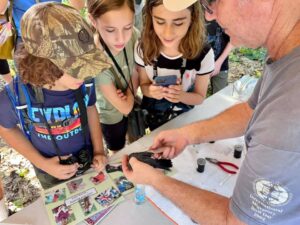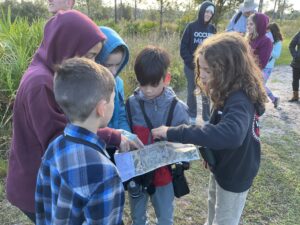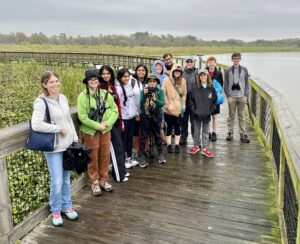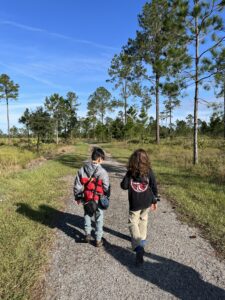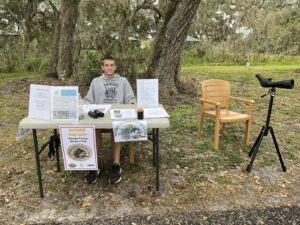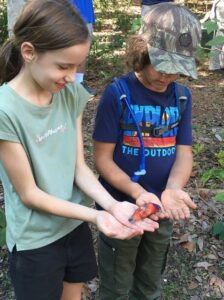Story and images by Jim McGinity
Most birders had some sort of “spark bird” or encounter that ignited their interest. For me, it was hearing a strange sound in the backyard. I borrowed my dad’s giant Navy binoculars and chased the elusive sound all around the neighborhood. It turned out to be a house wren and I was hooked! In addition to discovering a curiosity for birds on my own, my interest was encouraged by my parents and a local mentor who led a bird walk every Sunday morning. I was usually the youngest person in the group, and I wished to be with birders my own age.
Fast forward 50 years to the internet and social media era. Although nearly unlimited information about birds is available, finding peers can still be difficult. That is where young birders clubs come in. It started in 2006, when a few young birders in Ohio approached the staff at the Black Swamp Bird Observatory. That effort was so successful that they created a toolkit for how to run a successful club. Now there are young birders clubs in 25 states as part of Global Young Birders Network.
Living in a state with 4.3 million children under the age of 18, it just makes sense to have a young birders club in Florida. As an environmental teacher at Learning Gate Community School in Lutz, I work with students from kindergarten through fifth grade. Three years ago, two, third-graders were soaking up everything I taught them about birds. I realized I couldn’t wait any longer – they could lose that spark of interest if there wasn’t a way to encourage them.
Collaboration is Key:
Just like our mascot, the Florida scrub jay, the club is a social group that needs helpers to thrive. Local Audubon groups – also aware of how important it is to reach out to younger people – were very supportive of the idea, so we “hatched” a local group with the support of Tampa Audubon. Then I met two other birders working with young people, Kathy Rigling of Orange Audubon and Kate Milutin of St. Johns Regional Audubon, and we joined forces.
The next step was finding a larger organization with an overlapping mission. As luck would have it, the president of the Tampa Audubon Society is also the president of the Florida Ornithological Society (FOS), and Ann Paul was very excited to help out with this new initiative. “This is an opportunity for children to learn about birds together, and they’re learning about science while exploring the natural areas of Florida. Projects like the Florida Young Birders Club that encourage kids to experience real-life outdoors are truly important to the world’s future.”
With support from FOS, we now have active chapters in Tampa, Orlando and St. Augustine with new ones forming in Manatee/Sarasota, Charlotte Harbor and Gainesville. We hope that in the next year or two we will be able to partner to expand into the heavily populated and diverse southeast region of the state as well as the Panhandle/Northwest region.
What is a Young Birders Club?
While most young birders clubs focus on middle/high school ages, given the interest of my third-grade students, we decided to focus on kids who are 9 to 17 years old. Each month, young members can participate in field trips chosen specifically to meet their interests. Additionally, they participate in service projects focused on habitat restoration and conservation projects, such as building American kestrel nest boxes and assisting with shorebird monitoring programs.
The FYBC goal’s include:
· Creating a young birder community throughout Florida
· Fostering an interest in natural history and encouraging young people to spend more time outside
· Providing leadership training and opportunities
· Introducing young people to career opportunities in the wildlife, research, and conservation fields
· Connecting young birders with adult mentors willing to share their time, knowledge, and transportation
· Most importantly, having fun!
It Takes a Village
Parents also are key to the success of our young birders. Along with providing transportation, they support their children in developing knowledge and leadership skills. “The Young Birders Club has allowed my daughter to connect with like-minded kids who share her love of nature and birds,” said Des Perry of Tampa. “She’s gained exposure to experts and events we would have never known about before. It’s a fantastic experience for not only her but us parents as well. We learn from the kids and have created great friendships through the group.”
Activities depend upon the age of the child. Younger children learn basic birding skills, while the older young birders go on longer outings and take on projects and leadership roles in the club. Melanie Fowler, Lakeland, Florida shares, “From a parent’s perspective, I see FYBC as more than ‘birds.’ It provides children and teens opportunities to engage in scientific thinking and skills, develop friendships, and gain leadership experience. I continue to be impressed with the varied outings and the welcoming culture.”
The club has also connected with a variety of professional biologists, professors and expert birders to learn about their work. On field trips to see burrowing owls and Florida scrub jays, local land managers donate their time to show young birders these special birds. They heard about the life history and conservation challenges for these species and what it is like to work in the field.
Through the monthly “Jay Chat” online program, members have learned from professionals who have generously donated their time to reach out to children who could become the next generation of ornithologists. The FYBC also has forged a partnership with Vortex Optics that allows us to offer a significant discount, bringing the cost of binoculars down so that families and clubs can put quality optics into the hands of young birders.
Activities/Events:
The activities are based on the interest of the members. At the beginning of each fall, each group gets together for a bird walk at a local park/preserve. After birding for a few hours, we sit down to discuss what types of field trips they would like to do. The group brainstorms habitats they would like to explore, species to search for, and service projects they would like to perform.
As an adult leader, it has been difficult to keep quiet and let the kids guide the planning. I keep my older people’s cynicism to myself when they suggest what to me sounds like crazy ideas. Quite often, these ideas turn out to be fun activities (like doing a Florida Big Day for kids with prizes). Either way, the kids have the satisfaction of deciding what the group ends up doing.
Just like any bird club, there are a variety of monthly field trips and we do service projects like building nesting boxes. Twice a year, we plan statewide outings to hotspots like Orlando Wetlands and Sweetwater Wetlands (Gainesville) that allow young birders to bird together and get to know one another. Our plans also call for holding an annual day-long conference at a unique location to allow members to share their knowledge and hear from experts in bird conservation.
Since many young birders in Florida won’t live close to a chapter that offers regular outings, the club came up with a virtual program to allow all kids to continue learning about birds. The young birders on our FYBC Advisory Committee wanted to hear from the experts around the state. The coordinator—a young birder himself—contacted bird researchers and expert birders to present one of the club’s monthly “Jay Chats.”
It’s wonderful to see the enthusiasm from experts who welcome the chance to share their work with members of the next generation. The programs are open to birders of all ages but the Q & A at the end is reserved for the kids. There is also a social time via Zoom to allow the young birders to share and build their community. For those who are interested, all the “Jay Chats” are archived and available on the FYBC YouTube channel.
Leading the “Flock”
As FYBC evolves, it is important to remember that this club is their club. They need to be involved in the major decisions that shape the club whenever possible.
“The best part of the Florida Young Birders Club, for me, has been the opportunity to connect with other young birders and help build a community,” said Charles Law, one of the older young birders. “Designing club materials and participating in events is fulfilling, informative and fun. I really appreciate the opportunities that I have had as part of the FYBC!” In addition to being one of two designers of the club’s logo, he has participated in local outreach efforts, set up the YouTube and TikTok accounts, and creates YouTube shorts featuring a different bird each week.
And unlike older birders who may think about new initiatives for a while before acting, the young birders come up with an idea and are fearless in jumpstarting a project. One example is when the young birders on the advisory committee said that they wanted to hear from bird experts and professionals in Florida. Along with learning about current research, they also were interested in hearing about potential career options that involve birds and bird conservation.
Blair Clark of St. Augustine Beach stepped up to the opportunity to coordinate the “Jay Chat” monthly online series. “I have loved coordinating our Jay Chat speaker series for the FYBC,” he said. “Having the opportunity to learn from and make connections with expert birders and researchers has allowed me to expand my knowledge and discover what is possible for me as I plan for college and my future.”
All he needed was a contact list for bird guides and researchers, and he was off and running. Blair organized a process for tracking potential speakers, contacted and scheduled them, and moderated the programs
The adult mentors for each of the chapters and on the advisory committee are integral to the operation and expansion of the FYBC. Each chapter requires at least one dedicated adult (often more) to organize the activities and support the young birders as they develop their birding skills. Kathy Rigling, Orange Audubon, shares how rewarding it is to work with the youth through this program. “It is heartening to see the level of enthusiasm of the young birders I have been working with for the past year in the Orange Audubon Society’s Young Birders Club. They are at all different levels and abilities, but each one has shown great enjoyment on our trips, whether they are spotting a rarity for our area or they find some frogs to explore on a local trip.”
Birds of a Feather – How You Can Help:
Most serious birders are more than willing to share their passion. To help FYBC grow, we’re asking them to spread the word if they see young people out birding. Floridians can visit the FYBC website,https://floridayoungbirders.org/, FOS website or FYBC Facebook page to connect with us. We have even created business cards with a QR code on them that can be carried by adult birders and given to interested young birders.
Donate your time or expertise to help existing clubs. This could include helping with the website/social media, volunteering your graphic design skills, or helping organize a bird walk at your local school or community center. Lastly, there is always making donations to purchase optics, create scholarships for young birder camps, or becoming a sponsor. Donations to the club can be made via the FOS website Paypal button.
Fledging the Young Birders:
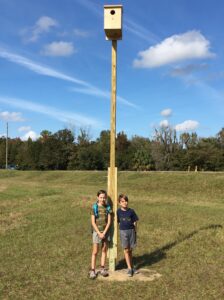
As with any educational endeavor, sometimes it is difficult to measure the impact of the lessons we impart to the youth. It can be years later, when they reconnect either directly or indirectly that you see how the exposure to birding, bird conservation and careers impacted them. In some cases, it can lead to a lifelong passion (some may say obsession) for birds or in other cases, it may be the spark that leads them to pursue careers in bird conservation.
I think one of our young birders Ethan Landreville of Melbourne, Florida, sums it up best. “The FYBC is a way for young birders to connect, share knowledge and past experiences, and strengthen the birding community’s relationship with birds and the wilds of Florida. The club also works towards spreading the word about birding, so that young generations are inspired and involved in environmentalism early on. By educating those who will one day be making important decisions for our region and its unique wildlife, we ensure there will be thought given into every action, small or large, with the well-being of both humans and wildlife in mind.”

